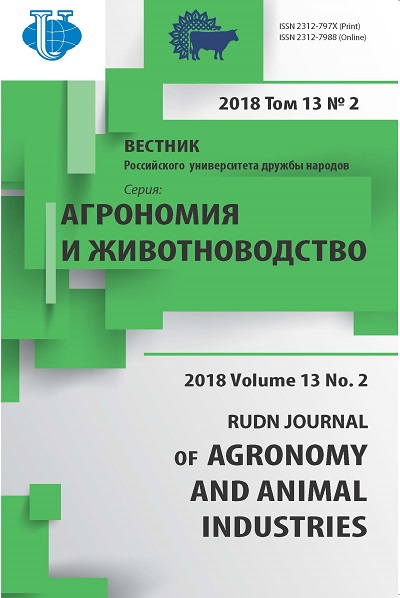Morphobiological features of buck lambs by using high protein extruded food
- Authors: Chamurliev NG1, Mandzhieva MV1
-
Affiliations:
- Volgograd State Agricultural University
- Issue: Vol 13, No 2 (2018)
- Pages: 131-137
- Section: Morphology and ontogenesis of animals
- URL: https://agrojournal.rudn.ru/agronomy/article/view/18686
- DOI: https://doi.org/10.22363/2312-797X-2018-13-2-131-137
- ID: 18686
Cite item
Full Text
Abstract
The development of internal organs and the morphological composition of carcasses of the sheep’s ox of Volgograd breeds when feeding them grain extruded forages with the use of dry beer pellets (EKKO-PD-SM) and pumpkin cake (EKKO-PC-SM) in combination with natural sulfur and methionine. Studies have established that sheep of experimental groups by the mass of internal organs were superior to the peers of the control group. Thus, the animals of the I and II-experimental groups had an advantage in comparison with the control peers: by weight of the leaked blood 9.24 and 11.54% (P ˂ 0.05); by weight of heart 12,41 and 16,47% (Р ˂ 0,05); by weight of lungs 8.60 and 11.34% (P ˂ 0.05); by weight of the liver 8,40 and 10,93% (Р ˂ 0,05); by weight of spleen 22,06 and 24,11% (Р ˂ 0,05) respectively. By the mass of the kidneys, there is no reliable difference in the compared groups, although the tendency of its increase in the animals of the experimental groups was noted. Buck lambs of I and II-experimental groups exceeded the control peer by weight of the stomach without contents by 8.04 and 10.57% (P ˂ 0.05), by weight of the small intestine by 9.07 and 12.29% (P ˂ 0.05), by weight of carcass (by 10.78-14.66%), by weight of pulp (by 17.19-22.81%), respectively.
About the authors
N G Chamurliev
Volgograd State Agricultural University
Author for correspondence.
Email: zootexnia@mail.ru
-
Universitetskiy pr , 26, Volgograd, Russia, 400002M V Mandzhieva
Volgograd State Agricultural University
Email: zootexnia@mail.ru
-
Universitetskiy pr , 26, Volgograd, Russia, 400002References
- Fotov P.G. Efficiency of the application of extruded and granulated grain forages in motley grass rations when fattening bulls [Ph.D.]. Saransk; 1985.
- Devyatkin A.I. Rational use of feeds. Moscow: Rosagropromizdat; 1990.
- Kuznetsov S.G. Biochemical criteria for the provision of animals with mineral substances. Review. Sel’skokhozyaistvennaya biologiya. 1992;2: 16—33.
- Rudometkin A.S. Development and scientific substantiation of the way of production of grain products on a twin-screw extruder [Ph.D.]. Voronezh; 2002.
- Nadarinskaya M.A. Selenium in the feeding of highly productive cows. Zootechniya. 2004;12: 10—11.
- Buzoverov S.Yu. Influence of extrusion and chemical method of “Protection” of fodder protein on metabolism and productivity of lactating cows [Ph.D.]. Krasnoyarsk; 2008.
- Gorlov I.F. Use of new biologically active additives in the production of beef. Dairy and Beef Cattle Farming. 2011;5: 32—34.
- Kolosov Yu.A., Zasemchuk I.V., Borodin A.V. Use of domestic genetic resources for the improvement of Merino sheep: scientific and practical recommendations. Persianovsky; 2012.
- Aboneev V.V. Selective and technological methods for increasing the competitiveness of fine-fleeced sheep breeding. Sheep, goats, woolen business. 2015;3: 3—5.
- Trots N. Feed advantages of extruded grain fodder. 2015: 126—140.
- Aduchiev B.K. Influence of fodder additive “M-Feed” on the digestibility and use of nutrients in rations by sheep’s fattening breeds. Zootechniya. 2015;7: 10—13.
Supplementary files















